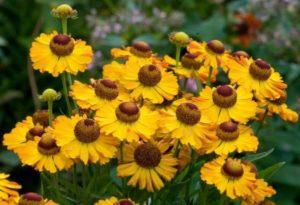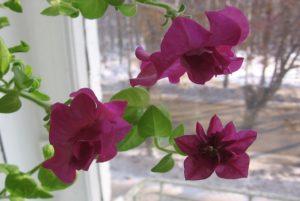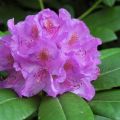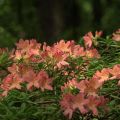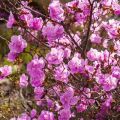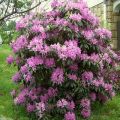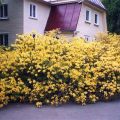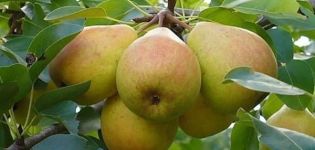Description and characteristics of the Hague rhododendron variety, planting and care
There are a large number of evergreen shrubs valued for flowers. However, in the harsh climatic conditions, not all of them are able to survive the local winter. Therefore, Russian gardeners appreciated the rhododendron variety The Hague. Against the background of his fellows, he pleases connoisseurs with high frost resistance and the ability to endure freezing temperatures in an open space without losing the ability to bloom.
Brief definition
The Hague rhododendron is a hybridized species of evergreen rhododendrons. It was bred in Finland through experiments with the Vereskov family.
Detailed description
Rhododendron The Hague belongs to an evergreen shrub with a dense spherical crown and dense branches. It is capable of blooming in the sun, in a shaded place, for a period of 2-3 weeks by the end of May or in June. Flowers are collected in inflorescences, in connection with the breeding of new varieties, a common feature can only be called a wavy edge and a grouping of inflorescences of 17-20 flowers. The buds of the rhododendron are red, the foliage is dark, dense and glossy, up to 13-15 centimeters.
History of origin
The breeding of the Hague rhododendron is attributed to Finland, and the date is 1974, the time of breeding by the University of Helsinki during the period of the rhododendron breeding program. A hybrid originated from the Katevbinsky rhododendron and is its short-fruited variety. In turn, today The Hague has more than 80 varieties.
Distinctive features
Finnish rhododendron varieties have been adapted to the climatic conditions of the breeding site. That is, they have a very high resistance to cold, which makes it actually possible to keep a tropical flower in the northern region.
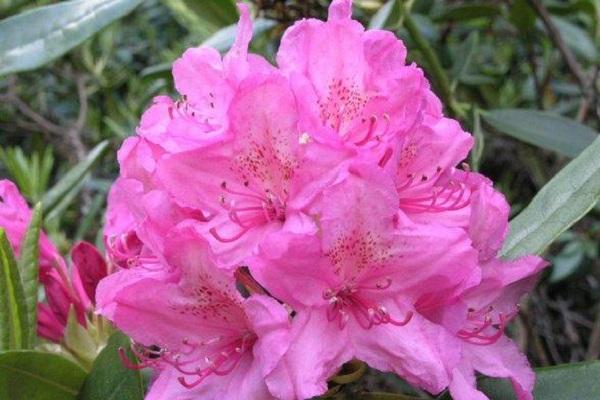
Landing
Rhododendron The Hague is a variety that is resistant to many adverse conditions, including planting it is tied mainly to the acidity of the soil and the level of humidity. But for better growth, a number of recommendations should be considered.
Seat selection
Rhododendron adapts well to both the sun and shaded areas. But in the first case, he needs protective shelters from the direct rays of the sun. It is better to protect from drafts, despite frost resistance. The plant loves humid air, so the best option would be to land on the shore of a pond or other body of water.
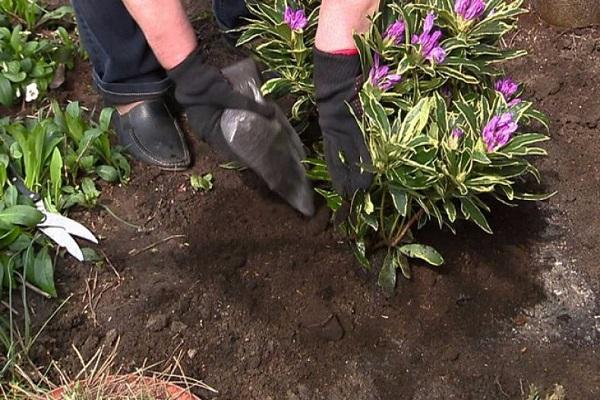
Soil preparation
Land for planting should be loose and acidic. The ideal composition is as follows:
- drainage base;
- 1 part of the land is sod;
- 1 part coarse sand;
- 3 parts of peat;
- 2 parts of heather land.
Pit preparation and planting scheme
A hole is prepared 40-45 centimeters deep and ten centimeters wider. The drainage is covered by 10-15 cm, then the place is filled with soil mixture and tamped. A seedling is placed in the recess, which is covered with a substrate along the root collar and watered abundantly. Mulching (5-6 centimeters thick) with a combination of decayed needles, moss, peat, leaves and pieces of oak bark will be beneficial.
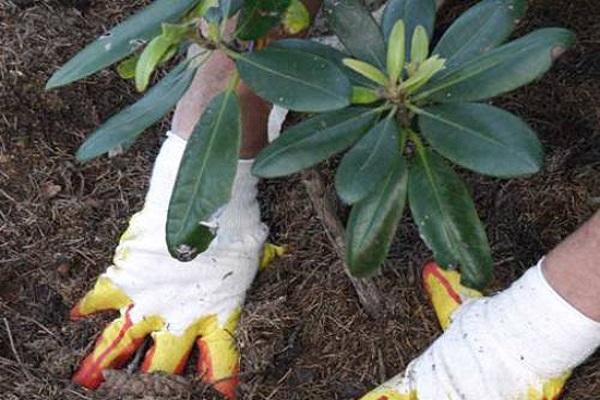
Care features
There are no difficulties in keeping the Hague rhododendron. It adapts well to new conditions compared to related species. Subject to the rules of watering and feeding, the plant will be healthy and blooming well.
Watering
Winter and autumn watering of the rhododendron is carried out only on dry days, while in summer the bush requires irrigation and spraying every day. In this case, settled cool water or (ideally) rainwater is suitable. It is sometimes recommended to diversify watering with a sphagnum peat solution. To do this, it is soaked in small quantities in water for a day.

Top dressing
It is worth starting to feed the plant immediately after planting the bush, and is fertilized throughout the entire flowering. For acidification purposes, the water is diluted with ammonium, calcium and superphosphate. At the beginning of spring, it is worth adding 4-5 grams of magnesium sulfate per 10 liters of water for fertilizing with nitrogen. By the middle of summer, fertilizing rhododendron costs half as much.
Pruning
A mature shrub is rejuvenated by pruning a third of old and damaged branches and upper, well-developed shoots. Treat the sections with garden pitch in the spring.
A month later, the buds begin to awaken and the intensive growth of new shoots begins.
Transfer
The period for transplanting to a new place should also be chosen in the spring, guessing the moment between two flowering. At this time, the plant is unpretentious, quickly adapts, and transshipment will not turn into problems.

Substrate composition:
- 40 grams of sulfur;
- 1 part sand;
- 1 part sawdust;
- 2 parts sour peat.
Bloom
Rhododendron is valued precisely as a flower bush that blooms well even after a harsh winter. The flowers themselves, with reddish freckles and wavy petals, make up an inflorescence in a group of 17-20 pieces. The shade, depending on the variety / sub-variety of the plant, varies from salmon and pink to purple and red.
Features:
Blooms in large numbers, pyramidal or forming a round crown. It starts at a fairly early date. Bloom lasts 3 weeks on average, from May to June.
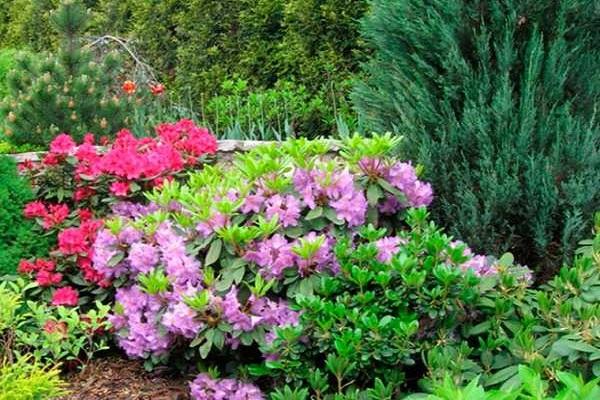
How to care before and after
It is necessary to collect wilted inflorescences and flowers from the rhododendron so that it does not waste nutrients. During the formation of buds, the temperature should be about 10-15 degrees, in the immediate period of flowering, you can increase it by another five. It is also necessary to ensure regular watering with good lighting.
If buds do not appear
There are three possible reasons that can inhibit the development and flowering of rhododendron. First, you need to check for garden pests. If they are not there, the flower may lack minerals or moisture. It is necessary to make additional feeding and try to increase watering. In summer, it is recommended to spray the plant every day.
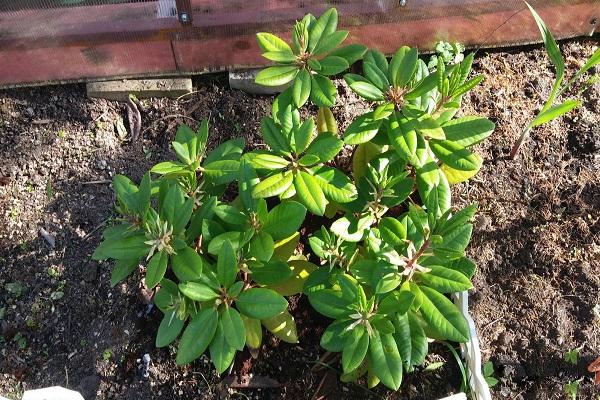
Reproduction
Reproduction of the Hague variety, like other types of rhododendron, is possible both by seeds and vegetatively (cuttings, layering).
The seed method is usually used for wild-growing varieties. The planting is carried out in bowls (with a large amount - in boxes), which are covered with clean sand and watered with either melted or rain or well-settled water, acidifying the soil with oxalic acid.After sprouting, it is advisable to move the sprouts to a cooler place, 10-12 degrees, so the seedlings are less sick. The seed-grown rhododendron blooms in the 5-10th year of life.
Lignified shoots of 7-8 centimeters are cultivated in similar conditions, only protecting with glass or film and on the basis of peat soil. It takes root within 2-3 weeks, and the plant grown from the cutting can bloom after a year.
Planting young plants outdoors should be directly in boxes.

Use in design
It fits harmoniously into the company of other rhododendrons, especially with orange flowers. Looks good on a green lawn, shaded with juniper, thuja, pine trees.
Problem prevention
Rhododendron The Hague is not the most demanding plant to care for outside the flowering period, and it is quite simple to organize the prevention of problems. In late autumn, early spring, it is recommended to treat it with a solution of Bordeaux liquid (copper sulfate in lime milk).
With excessively diligent watering, the plant is affected by a fungus (signs - improper leaf pigmentation, rust and chlorosis). It is necessary to reduce the amount of water. Rotting shoots that arise for the same reason are also immediately removed. The problem of yellowing leaves is solved by treatment with iron chelate.

Not a single plant is insured against pests. The rhododendron of the Hague, for example, often affects snails and slugs. It is not difficult to neutralize them, you must pick them up manually. If a weevil attacked the bush, then the surrounding substrate, branches and leaves are treated with Diazonin solution.
In the case of a spider mite and a specific pest of the rhododendron bug, spraying with fungicides (for example, an 8% solution of "Karbofos") will save the situation.
Reviews
Khmelkovskaya Miroslava Vasilievna, 38 years old: “I have the Hague rhododendron variety growing. Planted last year. She made him a hut for the winter as a shelter. Last weekend I was at the dacha. The Hague rhododendron wintered well: the buds did not fall off, no spots are visible on the leaves, the leaves rose, straightened. "
Polyakova Svetlana Stepanovna, 55 years old: “The incredible beauty of the Hague rhododendron! I concluded that it is good to mulch with pine needles. This variety really meets all the characteristics declared by the selectors both in terms of care and in terms of abundant flowering. "
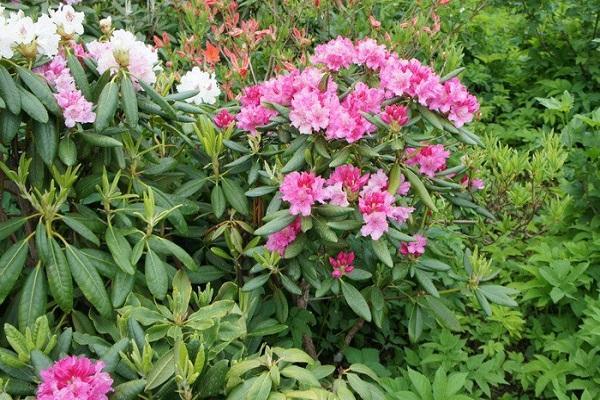
Conclusion
Considering all factors, the Hague rhododendron can deservedly be called a very unpretentious and hardy variety. With proper care and minimal costs, it will thank the owner with lush flowering and contribute to the picturesque garden.
